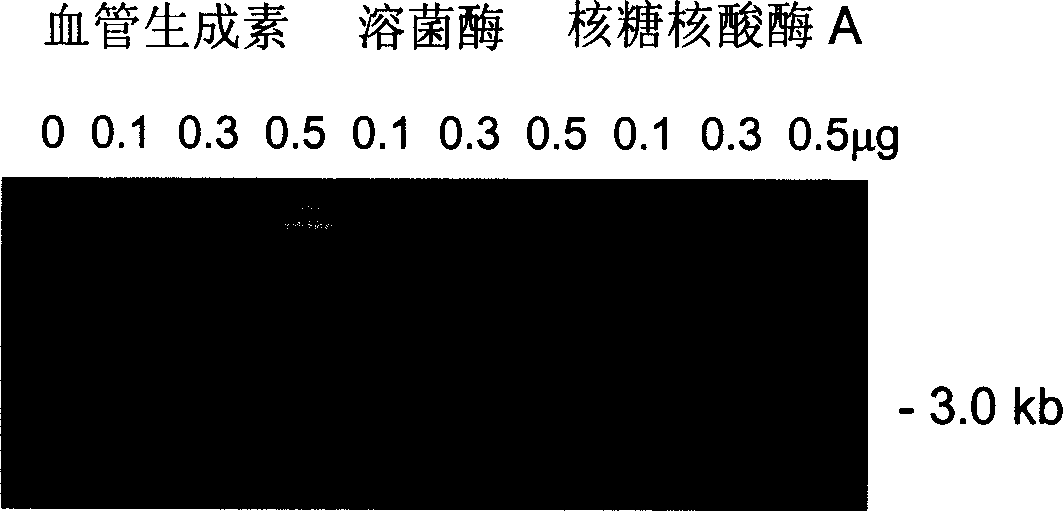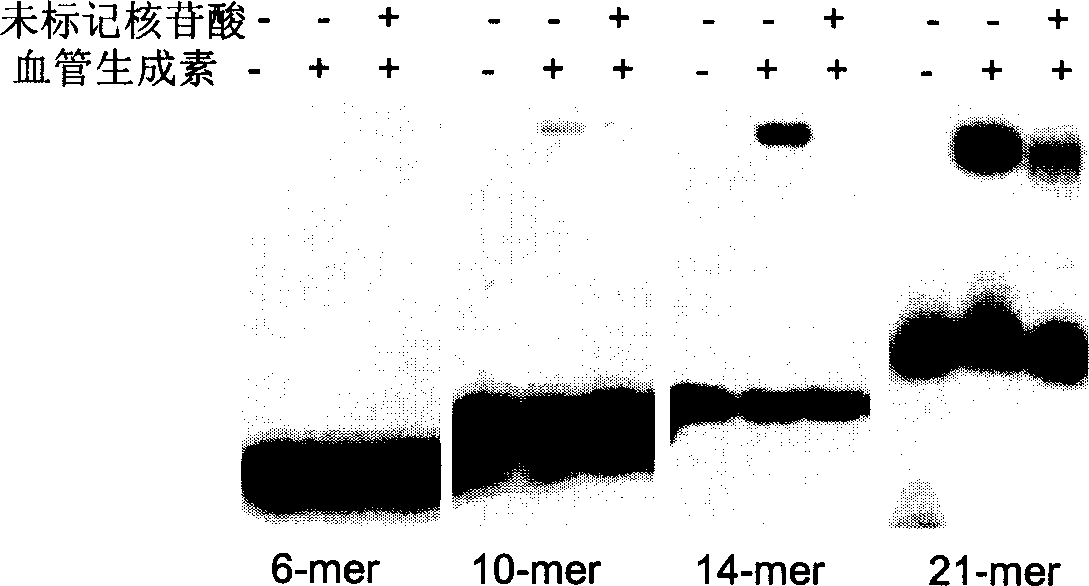Anti-angiogenesis and anti-cancer function of angiogenin combined with nucleotide
An angiogenin and oligonucleotide technology, applied in the direction of angiogenin, angiogenesis factors, medical preparations containing active ingredients, etc., can solve the problem of no effective technology for inhibiting rRNA transcription
- Summary
- Abstract
- Description
- Claims
- Application Information
AI Technical Summary
Problems solved by technology
Method used
Image
Examples
Embodiment 1
[0050] cell culture
[0051] Human placental vein vascular endothelial cells (HUVE) were cultured in vascular endothelial cell-specific medium (HE-SFM+10% FCS+10ng / ml bFGF) containing 10% fetal bovine serum and 10 ng / ml basic fibroblast growth factor )middle. The culture conditions are constant temperature and humidity at 37°C and 5% carbon dioxide gas phase. The medium was changed every two days, and the culture medium was subcultured at a ratio of 1:3. HUVE cells from passage 3 to passage 15 were used for experiments.
[0052] Human placental venous vascular smooth muscle cells (HuASM), human cervical cancer cells HeLa and human colon adenocarcinoma cells HT-29 were cultured in DMEM containing 10% fetal bovine serum and subcultured at a ratio of 1:4.
[0053] U-937 cells were cultured in RPMI containing 10% fetal bovine serum and subcultured at a ratio of 1:4.
Embodiment 2
[0055] Isolation of angiopoietin-binding nucleotides
[0056] Angiogenin enters the nucleus of vascular endothelial cells and induces the synthesis of total RNA (Xu ZP, TsujiT, Riordan JF, and Hu GF. The nuclear function of angiogenin inendothelial cells is related to rRNA production, Biochem.Biophys.Res.Commun.2002 , 294, 287-292). Since Northern blot showed that angiogenin stimulates the synthesis of ribosomal ribonucleic acid (rRNA), a series of experiments were performed to demonstrate the binding of angiogenin to the transcriptional regulatory region of ribosomal ribonucleic acid gene (rDNA).
[0057] First, a 4.6kb rDNA transcriptional regulatory region fragment was obtained and treated with restriction endonuclease DpnI to obtain 5 smaller fragments. Gel electrophoretic mobility experiments showed that angiopoietin bound to the 3.0 kb fragment, but had no effect on the other 4 fragments (Fig. 1).
[0058] Figure 2 shows that the binding of angiogenin to a 3.0 kb DNA f...
Embodiment 3
[0060] Cloning and sequence analysis of angiopoietin-binding nucleotides
[0061] In this example, in order to further analyze and identify the properties of angiopoietin-binding nucleotides, their sequences were determined.
[0062] The conjugate of the 3.0 kb DNA fragment and angiogenin was treated with deoxyribonuclease (DNase I). In this way, only the nucleotides directly bound to angiogenin will not be enzymatically digested. After these fragments were isolated and cloned, the nucleotide sequences were determined. Figure 3 lists the sequences of five such clones. The commonality of these 5 sequences is that they are all rich in C and T, and contain CT repeats. The sequence of clone No. 12 (CTCTCTCTCTCTCTCTCCCTCTC, SEQ ID NO: 1) was the shortest and was named as angiopoietin binding element (ABE).
PUM
| Property | Measurement | Unit |
|---|---|---|
| diameter | aaaaa | aaaaa |
Abstract
Description
Claims
Application Information
 Login to View More
Login to View More - R&D
- Intellectual Property
- Life Sciences
- Materials
- Tech Scout
- Unparalleled Data Quality
- Higher Quality Content
- 60% Fewer Hallucinations
Browse by: Latest US Patents, China's latest patents, Technical Efficacy Thesaurus, Application Domain, Technology Topic, Popular Technical Reports.
© 2025 PatSnap. All rights reserved.Legal|Privacy policy|Modern Slavery Act Transparency Statement|Sitemap|About US| Contact US: help@patsnap.com



